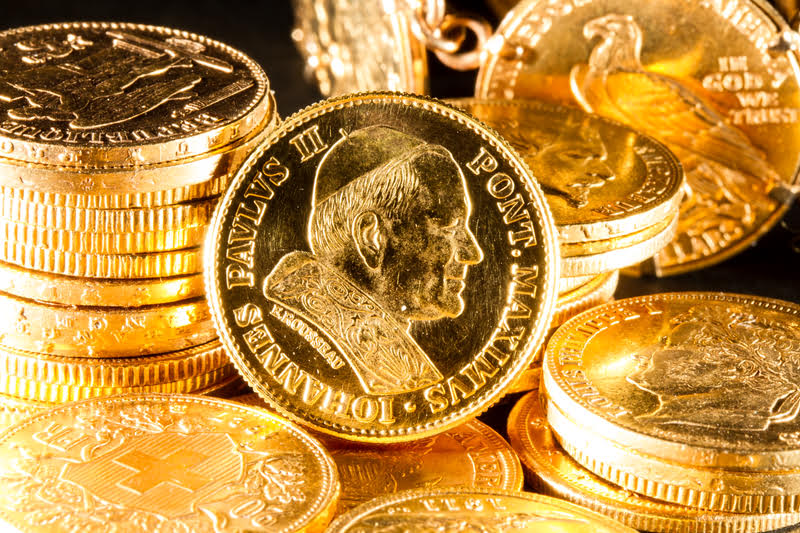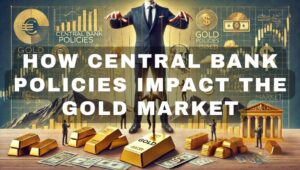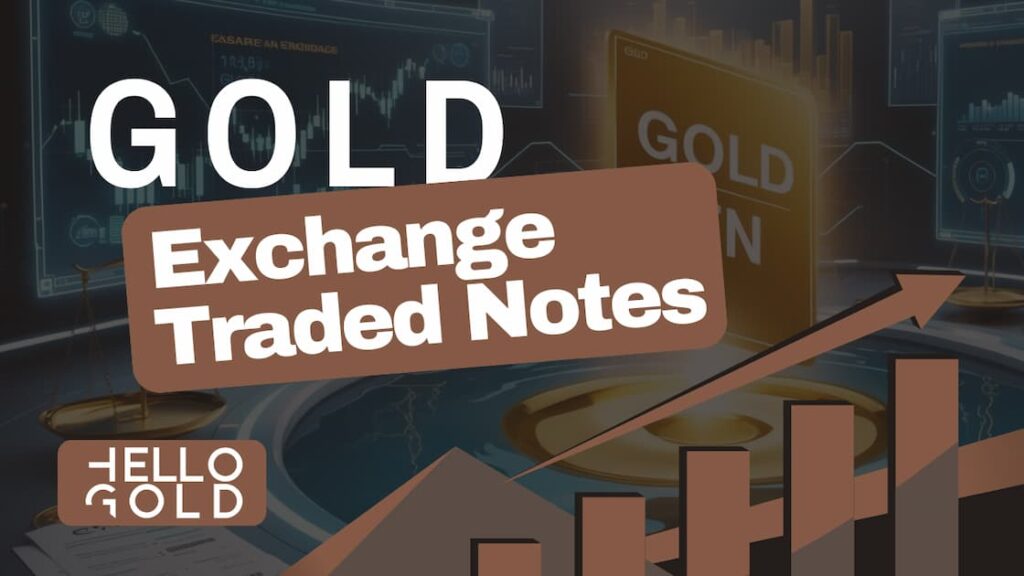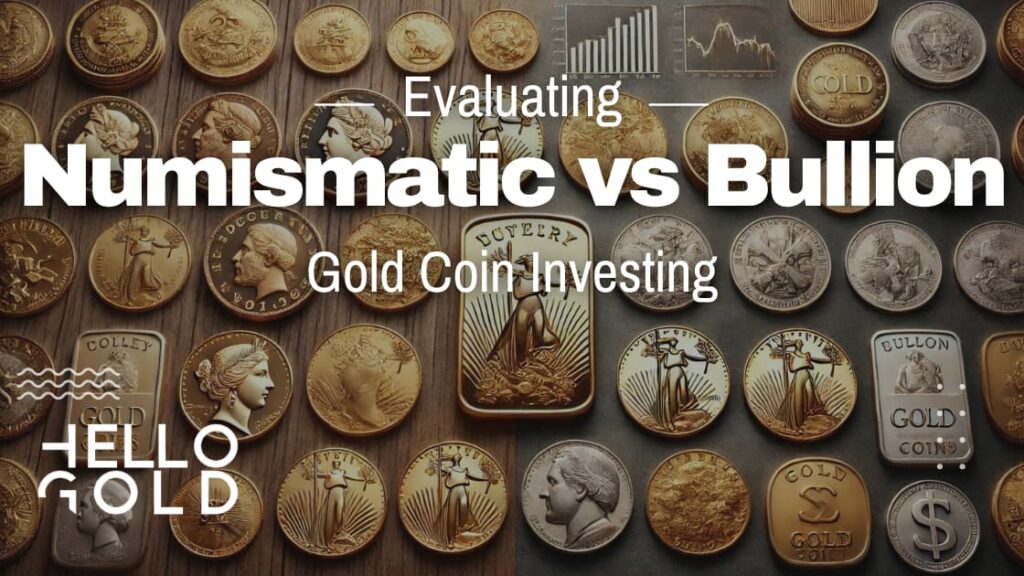Introduction
Gold is not just a precious metal – it’s a sturdy financial asset with enduring value.
As an investor, you know gold provides stability when markets are volatile and acts as a hedge against inflation during times of economic uncertainty.
However, the factors influencing gold prices are complex and constantly evolving.
To capitalize on trends in the gold market and protect your investments, you need to stay informed and adapt to innovations in technology that are transforming how gold is traded.
This article provides an in-depth overview of the economic forces, emerging technologies, and global dynamics that drive gold prices and shape the future of gold investing.
By understanding these influences, you’ll gain insights into expert predictions on where gold prices are headed and strategies to navigate market fluctuations.
Whether you’re a newcomer to gold investing or an experienced investor, the knowledge in this article will help you make confident decisions about your long-term gold investment strategy.
The Impact of Economic Factors on Gold Prices
Economic forces play a crucial role in determining the value of gold.
Understanding these factors can help you make informed decisions when considering gold as an investment.
In this section, we will examine several key economic factors that influence gold prices.
Central Bank Gold Purchases
Significant impacts on gold prices can be attributed to central bank gold purchases.
In 2019, central bank gold purchases reached a 50-year record, driving up gold prices.
In 2022, these purchases surpassed the 2019 record levels again.
Central banks buy gold to strengthen their reserves, and their actions can directly affect the demand and price of gold.
Value of the U.S. Dollar
A crucial factor for gold prices is the value of the U.S. dollar relative to other currencies.
Gold is priced in dollars, so when the dollar weakens against other currencies, gold demand increases, leading to higher gold prices.
Conversely, a stronger U.S. dollar can push gold prices lower.
Inflation and Gold
There is a complex relationship between inflation and gold. Gold is often seen as a hedge against inflation.
However, in 2022, despite soaring inflation, gold prices initially declined due to the strength of the U.S. dollar before eventually recovering.
This example demonstrates that the relationship between gold and inflation is not always straightforward.
Gold Jewelry Demand
Driving gold prices higher is the demand for gold jewelry.
India, China, and the U.S. are the largest consumers of gold jewelry.
As demand increases in these markets, gold prices tend to rise.
Gold as a Safe Haven Asset
Seeking security in uncertain times, investors often turn to gold as a safe haven asset.
During recessions and periods of economic uncertainty, more people invest in gold as a way to hedge against events like currency devaluation and inflation.
This increased demand can drive up gold prices.
Exchange-Traded Funds and Gold Prices
Meeting investor demand, exchange-traded funds (ETFs) that hold gold can also impact gold prices.
Although these funds are designed to track gold prices, they can influence prices based on investor demand for their shares.
Gold Supply and Mining Costs
Influencing gold price fluctuations are factors related to the global gold supply, such as mining costs.
Conditions that restrict or expand the supply of gold can impact prices. Additionally, as mining gold has become more expensive over time, this can also affect gold prices.
Interest Rates and Gold Prices
There is a reverse correlation between interest rates and gold prices.
As interest rates rise, gold prices tend to fall, as investors prefer interest-bearing assets.
Rising rates make fixed income investments more attractive than gold, leading to decreased demand and lower gold prices.
Emerging Technologies and Their Influence on Gold
As technology evolves, it continues to revolutionize various industries, including the gold market.
Emerging technologies are transforming the way gold is traded, monitored, and managed, providing new opportunities and advantages for investors like you.
In this section, we will explore some of the most influential emerging technologies that are shaping the future of gold investing.
Blockchain Technology and Gold
Revolutionizing gold transactions, blockchain technology has made a significant impact on the gold market.
Blockchain enables secure, transparent, and decentralized tracking of gold ownership and transactions. This technology has paved the way for digital gold, allowing you to securely own and trade gold assets without the need for physical storage.
Blockchain also offers increased security through advanced encryption, reducing the risk of fraud and theft.
Artificial Intelligence in Gold Investing
Empowering smarter decision-making, artificial intelligence (AI) is transforming gold investing by providing advanced data analysis and predictive capabilities.
AI tools can analyze vast amounts of data, identifying patterns and trends that are difficult for humans to discern.
By leveraging AI-driven insights, you can make more informed decisions about your gold investments, maximizing potential returns and minimizing risks.
Real-time Data and Gold Price Tracking
Keeping investors informed, real-time data and gold price tracking technologies provide instant access to market trends and fluctuations.
Online platforms offer live charts, news, and analysis, ensuring you have the most up-to-date information when making investment decisions.
This real-time data allows you to monitor gold prices closely and make timely decisions on when to buy or sell gold assets.
Automated Trading Systems for Gold
Streamlining the investment process, automated trading systems are becoming increasingly popular among gold investors.
These systems allow you to set predefined rules and strategies for buying and selling gold, minimizing the need for manual market monitoring.
By automating the trading process, you can save time and reduce the risk of emotional decision-making, increasing the potential for consistent returns.
Electronic Roadshows and Gold Companies
Broadening investor outreach, electronic roadshows are an innovative alternative to traditional in-person roadshows.
Gold companies can present their projects and investment opportunities to a wider audience through webinars, video conferences, and other online formats.
This approach allows you to access a broader range of investment opportunities, connecting you with gold companies from around the world.
Gold Company Websites and Online Platforms
Enhancing communication with shareholders, gold company websites and online platforms are becoming essential tools for investor engagement.
Companies can share essential information such as financial reports, news releases, and corporate updates through their websites, providing you with easy access to the data you need to make informed investment decisions.
Additionally, interactive tools and multimedia features enable a more engaging experience that can help you better understand the company’s performance and prospects.
As you can see, emerging technologies have the potential to shape the future of gold investing in many ways.
By staying informed and adapting to these advancements, you can position yourself to capitalize on the opportunities they present and make well-informed decisions for your gold investment strategy.
Gold’s Role in a Shifting Global Economy
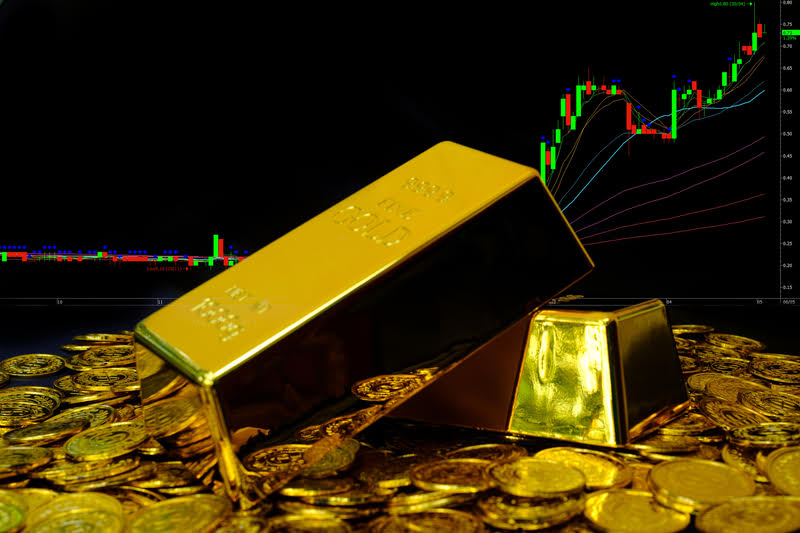
In a world where economic dynamics are constantly changing, gold continues to play a significant role in both developed and emerging economies.
In this section, we will explore the various ways gold impacts the global economy and its relevance in today’s financial landscape.
Gold as a Diversification Tool for Central Banks
Managing national currency reserves, central banks have long relied on gold as an essential part of their strategies.
Gold serves as a crucial diversification tool for central bank reserves, as they seek to maintain stability in their nations’ currencies.
Due to its unique properties, such as being a hedge against inflation and currency devaluations, gold remains a vital asset in central banks’ portfolios.
Gold’s Role in Emerging Economies
Shifting global dynamics have led to a rise in gold demand from emerging economies like Russia, China, India, and Turkey.
These countries have been increasing their gold reserves to strengthen their economies and protect against external financial shocks.
As a result, gold has become an even more critical component of their national strategies, further solidifying its importance in the global economy.
Gold and Currency Strength
Impacting international trade, the price of gold affects countries that import and export gold, influencing their currency values.
Countries that export gold or have substantial gold reserves will see their currency strengthen when gold prices rise, while countries that import gold will experience a weaker currency.
This relationship can have significant implications for international trade and economic stability.
Gold as a Hedge Against Inflation
Protecting purchasing power, gold has long been considered a hedge against inflation.
When currency values decline due to inflation, gold tends to maintain its value, functioning as a store of wealth when currency values are unpredictable.
As central banks rely on gold to guard against inflation and currency devaluation, you too can benefit from including gold in your investment portfolio to preserve your wealth during uncertain economic times.
Gold and Alternative Investments
Comparing options for investors, gold is not the only asset that can protect against inflation and economic instability.
Other investment options include low-cost commodity producers and Treasury Inflation-Protected Securities (TIPS).
It is essential to consider various investment alternatives and evaluate their potential risks and rewards to create a well-diversified and balanced portfolio.
Gold in a Post-Gold Standard World
Maintaining relevance, even though the gold standard has been abandoned, gold still plays a significant role in the global economy.
As a commodity, gold can act as a substitute for fiat currencies and be effective for hedging against inflation. Gold’s enduring value and unique properties ensure its continued importance in the financial world, signaling potential economic and currency challenges.
By understanding gold’s role in a shifting global economy, you can make more informed decisions about your investments and financial strategies.
Expert Predictions on Gold Price Trends
Listening to experts can give you valuable insights into the potential future of gold prices.
In this section, we will examine various expert predictions and forecasts to help you make informed decisions about your gold investments.
Goldman Sachs Predictions
Expecting significant growth in gold prices, Goldman Sachs recently updated its forecast, predicting a rise in the price of gold to $2,050/oz within the next year.
The firm cites factors such as increasing “fear” amid growing recession risks, as well as stress on the financial system due to banking and funding issues, as reasons for their upgraded prediction.
Goldman Sachs also emphasizes the role of gold as a safe haven asset, poised to perform better as an inflation hedge than cryptocurrencies during times of rising currency debasement risks and geopolitical tensions.
London Bullion Market Association Forecasts
Anticipating modest growth in gold prices, experts from the London Bullion Market Association predict the gold price to rise by approximately 3.3%-8.8%, bringing the value into the range of $1,859 to $2,025, by the end of 2023.
They have pinpointed the Federal Reserve’s monetary policy, inflation, and geopolitical events as the top three main factors influencing gold prices.
World Bank Gold Price Projections
Forecasting a downward trend in the coming years, the World Bank anticipated gold prices to average a 4% decrease in 2022 and experience an additional decline in 2023.
Their experts attribute this decrease to a reduction in financial investment demand caused by increasing U.S. real yields, making gold a less appealing option for investors.
Bank of America’s Gold Outlook
Recognizing the possibility for significant increases, Bank of America analysts have established a year end forecast with the price of gold targeting $2,200 per ounce.
They anticipate that the peak in interest rates, inability of central banks to control inflation, and an end to the hiking cycle will contribute to a rise in gold prices, in spite of obstacles from a robust U.S. dollar and declining jewelry demand.
ABN AMRO’s Gold Price Expectations
ABN AMRO anticipates a temporary decline in gold prices, with a subsequent rally.
The bank predicts gold values to dip to the $1,900-$1,950 range in 2023 before bouncing back to $2,000 in the same year and climbing to $2,200 in 2024.
Morgan Stanley’s Gold Forecasts
Anticipating strong performance in 2023, Morgan Stanley analysts expect gold prices to sit between:
– $1,990 per ounce to $2,200 per ounce in 2023.
They believe that dollar weakness, waning U.S. treasury appeal, and macroeconomic forces such as recession will push up gold prices, with risks skewing to the bull case.
Potential Challenges and Opportunities

While investing in gold presents a variety of opportunities, it also comes with its share of challenges.
As an investor, you should be aware of these factors to make informed decisions and capitalize on market trends and new technologies.
In this section, we will explore the potential challenges and opportunities associated with various types of gold investments.
Physical Gold: Traditional Investment Choice
Recognizing the advantages of physical gold, many investors opt for traditional investment options such as gold bars, coins, and jewelry.
Physical gold has long been considered a stable store of value and a hedge against inflation.
However, investing in physical gold comes with challenges like storage, security, and purity concerns.
Digital Gold: A Modern Opportunity
Adapting to new technologies, digital gold has emerged as an attractive alternative to physical gold.
Digital gold platforms allow you to buy, sell, and store gold online without worrying about storage and security. Investing in digital gold addresses concerns around storage, security, and purity, which are guaranteed.
However, it also comes with potential risks like fraud, market volatility, expenses, redemption limits, and taxation.
Gold ETFs and Sovereign Gold Bonds
Exploring alternative investment options, Gold Exchange-Traded Funds (ETFs) and Sovereign Gold Bonds (SGBs) offer several opportunities for gold investors.
These options provide capital gains and interest income, as well as high liquidity and ease of buying and selling on exchange platforms.
However, there are risks associated with these investments, such as market risk, charges, and redemption restrictions.
Regulatory Measures and Gold Investments
Understanding the role of government in gold investments is essential.
Regulatory measures like sovereign gold bonds introduced by the Indian government make gold investment easier and more attractive by providing benefits like tax-free returns and annual interest income.
Proper regulation and safeguards are needed to protect investors in the digital gold market.
Gold and Financial Inclusion
Expanding access to investment opportunities, digital gold has the potential to enable more individuals to save and invest.
Financial inclusion and frictionless onboarding are opportunities for digital gold to provide greater access to financial services in emerging economies where access is currently constrained.
Governments can promote digital gold through initiatives like gold bonds.
Gold Investment Risks
Navigating market volatility and other challenges is crucial for gold investors.
Gold investments, like any other investments, come with risks. These risks include market risk, inflation risk, currency risk, and geopolitical risk.
By understanding and managing these risks, you can make better investment decisions.
Gold Investment Opportunities
Capitalizing on market trends and new technologies, gold investors can benefit from various opportunities.
Digital gold platforms, gold ETFs, and SGBs provide opportunities for portfolio diversification, lower storage costs, and transaction transparency.
By staying informed and adapting to emerging technologies and market trends, you can position yourself to capitalize on the opportunities that gold investments offer.
Navigating Uncertainty
In these uncertain times, it is crucial for you, as a gold investor, to have a solid strategy to navigate market volatility and economic fluctuations.
By diversifying your gold investments, seeking safe havens, and exploring various options, you can better manage risks and maximize potential returns.
In this section, we will discuss several strategies that can help you make informed decisions about your gold investments.
Diversifying Your Gold Investments
Spreading risk across various assets is essential for mitigating potential losses and enhancing overall portfolio performance.
Diversification can be achieved by investing in different types of gold assets, such as physical gold, gold mining stocks, and gold ETFs.
This approach helps to balance out the performance of your gold investments, reducing the impact of market fluctuations on your portfolio.
Safe Haven Assets and Gold
Finding stability in turbulent times, gold has long been considered a safe haven asset.
During periods of economic uncertainty, investors often turn to gold to protect their wealth and hedge against events like currency devaluation and inflation.
By including gold in your portfolio, you can benefit from its historical stability during challenging economic conditions.
Investing in Gold Mining Companies
A unique opportunity for growth lies in investing in gold mining companies.
These companies can offer potential returns even when gold prices are flat or declining, due to profits made from mining operations.
By researching and selecting well-performing gold mining stocks, you can benefit from the growth potential of the industry while diversifying your gold investments.
Gold Mutual Funds and ETFs
Simplifying gold investments for beginners, gold mutual funds and exchange-traded funds (ETFs) provide an easy and safe way to invest in gold.
These funds typically have lower fees and minimum investment requirements, making them more accessible for new investors.
Gold ETFs, in particular, offer a cost-effective way to gain exposure to gold prices, with annual expense ratios averaging around 0.61%.
Direct Exposure to Gold
Considering bullion and futures contracts, you can achieve direct exposure to gold prices.
Gold bullion, such as bars and coins, represents physical ownership of gold, while futures contracts allow you to speculate on future gold prices.
However, investing in these assets requires a higher level of expertise and may not be suitable for all investors.
Allocating a Portion of Your Portfolio to Gold
Balancing risk and reward, it is important to allocate an appropriate portion of your investment portfolio to gold.
A well-balanced allocation helps to protect your wealth during economic downturns while minimizing potential losses from market fluctuations.
The allocation percentage varies depending on individual risk tolerance and investment goals, but financial experts generally recommend a range of 5% to 10%.
Defensive Sectors for Gold Investors
Focusing on consumer staples, healthcare, and defense sectors can provide stability for your gold investments until the market outlook becomes less uncertain.
By investing in ETFs or single stocks within these sectors, you can benefit from the resilience they offer during economic turmoil.
For example, the SPDR ETF (XLP) that focuses on large-cap consumer staples companies is a suitable option for gold investors looking to diversify their portfolio and minimize risk.
By incorporating these strategies into your gold investment approach, you can better navigate uncertain times and maximize potential returns while minimizing risks.
As always, it is essential to stay informed about market trends and emerging technologies to make well-informed decisions for your gold investment strategy.
The Long-term Outlook for Gold
No one can predict the future with absolute certainty, but understanding potential factors influencing gold prices and keeping an eye on expert predictions can help you make informed decisions about your long-term gold investments.
Potential Price Peaks and Troughs
Navigating the market’s ups and downs is a crucial aspect of gold investing.
Gold prices can be influenced by a wide range of factors, including geopolitical events, economic shifts, and market sentiment.
By staying informed and prepared for potential fluctuations in gold prices, you can better position yourself to capitalize on opportunities and protect your investments during challenging times.
Geopolitical Factors and Gold Prices
The impact of global events on gold prices cannot be underestimated.
Geopolitical tensions and crises, such as trade disputes, wars, and political instability, can drive investors towards gold as a safe haven asset, resulting in increased demand and higher gold prices.
To navigate these influences, it’s essential to stay informed about global events and consider their potential impact on gold prices when making investment decisions.
Future Innovations in Gold Investment
Embracing new technologies and strategies can help you stay ahead of the curve in gold investing.
As emerging technologies like blockchain, artificial intelligence, and real-time data tracking continue to shape the gold market, staying informed and adapting to these advancements can provide you with new investment opportunities and tools for managing your gold portfolio more effectively.
Long-term Gold Price Predictions
Looking ahead to the next decade and beyond, various expert predictions offer insights into the potential future of gold prices.
For instance, Goldman Sachs predicts that gold prices could reach a new all-time high of $2,200 per ounce by 2025, while ANZ Research forecasts gold to trade at $2,000 at the end of 2023 and accelerate to $2,075 by September 2024.
By considering these expert predictions, along with your own analysis and understanding of market trends, you can make well-informed decisions about your long-term gold investments.
Gold’s Role in the Future Global Economy
Adapting to shifting dynamics, gold will continue to play a significant role in the global economy as a safe haven asset, store of value, and important component of central bank reserves.
As economic conditions and geopolitical factors evolve, gold’s role may change, but its enduring value and unique properties will likely ensure its continued importance in the financial world.
By understanding gold’s role in the global economy, you can make more informed decisions about your gold investments and better navigate the future of gold investing.
To Conclude
Gold will remain an integral part of the global financial system for years to come.
By understanding the factors influencing gold and staying ahead of emerging technologies, you can position yourself to capitalize on opportunities in the gold market.
Focus on diversifying your gold investments, pay close attention to expert predictions and global events, and ensure gold comprises a reasonable portion of your investment portfolio based on your risk tolerance.
The future is bright for innovative gold investors willing to embrace new strategies and tools to navigate price fluctuations.
Prepare now to take advantage of peaks and protect against troughs in the gold market over the long term. The opportunities are endless if you take action today.

